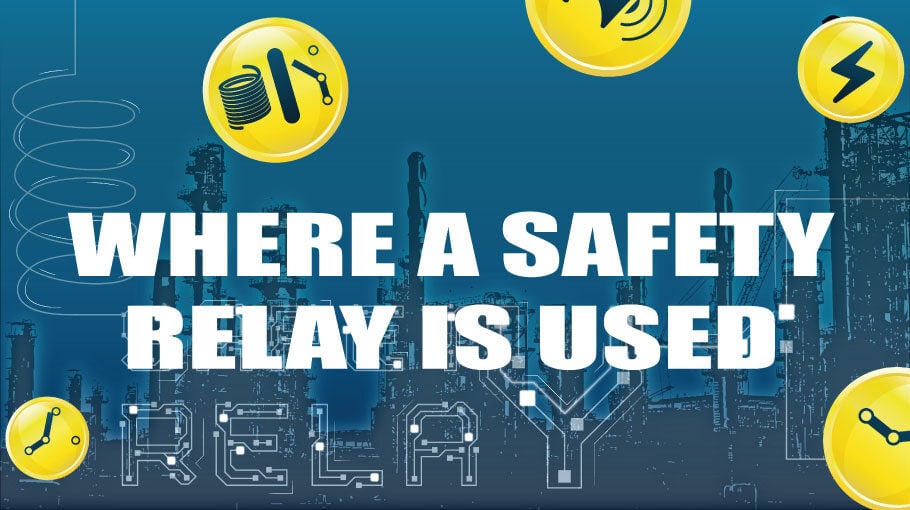There is a vast number of applications where safety relays are employed, spanning various industries. The common denominator of these environments is safety, which is always the top priority.
Safety relays play a critical role in achieving compliance with safety standards and regulations and preventing accidents and injuries in industrial settings. Safety relays are essential in applications where the prevention of accidents is managed by a safety instrumented system, particularly in the subsystems that constitute it. These subsystems, known as safety instrumented functions, are vital in many industrial applications and machineries. Safety relays are used in, but are not limited to, emergency stop systems, material handling, robotics and automation, elevators, as well as in the power, oil and gas, and process industries.
Industrial Applications
Now that all the key points about safety instrumented system (SIS) and safety instrumented function (SIF) have been clarified, it is clearer how important it is to have a safety relay, where safety is the primary concern. Each device or apparatus included in a SIF is used to create a safety loop where field devices control, detect and measure critical variables. When speaking about power interfaces, it is essential to mention safety relays, which are typically used to activate or deactivate valves, sounders, beacons, lights, or other actuators that might be required to bring the installation to the desired safe state. At this point, it is possible to take a quick look at real-life applications and see the various scenarios where a safety relay is used. Here are some specific situations where safety relays are commonly used:
Machinery and Equipment Safety
Safety relays are widely used in machinery and equipment to ensure safe operation. Their function includes monitoring emergency stop buttons, safety switches, light curtains, safety mats, and other preventive devices. Anytime one of these devices is activated, the safety relay initiates a safety response with its specific routine. This leads to a secure condition, preventing harm to personnel and operators, as well as inhibiting potential hazards to the equipment.
Emergency Stop Systems
Safety relays can be considered an essential part of emergency stop systems. These devices provide a means to shut down machinery or processes quickly and reliably in emergency situations.
Safety Gates and Access Control
Safety relays are also involved in the control of safety gates, access control systems, and perimeter fencing to prevent unauthorized access to restricted area. These areas are places where the presence of an operator is considered a threat for both the machine operation and, of course, the safety of the personnel.
Robotics and Automation
In robotics and automated systems, safety relays monitor robot movements and safety devices, ensuring safe operation by stopping or slowing down robots when operators enter the workspace.
Material Handling Systems
Safety relays are employed in conveyor systems and material handling equipment to monitor safety devices and ensure safe handling processes.
Process Control and Industrial Automation
In process industries, safety relays are used to implement safety interlocks and emergency shutdowns, protecting against abnormal conditions, and ensuring safe process control.
Elevators and Escalators
Safety relays are used in elevators and escalators to monitor additional safety devices, such as door safety edges and position switches, ensuring the safe operation of these transportation systems.
Automotive Manufacturing
Safety relays are used in automotive manufacturing to control safety functions in assembly lines and robotic applications, ensuring worker safety and preventing accidents.
Power Generation and Distribution
Safety relays are employed in power generation and distribution systems to protect against faults, overloads, and other safety-related events.
Fire and Gas Detection Systems
Safety relays are used in fire and gas detection systems to activate alarms, shut down processes, and initiate evacuation procedures in case of fire or gas leaks.
In summary, safety relays are used in a wide range of industrial and commercial applications where safety is a critical concern. They provide a reliable and fail-safe means of implementing safety functions, protecting personnel, equipment, and the environment from potential hazards and accidents. Using safety relays is essential for achieving compliance with safety standards and regulations and ensuring the overall safety and reliability of industrial systems and processes.
Safety Relays for Critical Applications
A safety relay can be used to monitor potential failures in machinery or plants. When such events occur, the safety relay initiates a response to restore normal operation and reduce the risk to an acceptable safe level. It is extremely important to follow and comply with the regulations or industrial standards in force according to the classification of the application. Safety relays must also be designed so that, if wired correctly, neither a fault in the device nor an external fault caused by the sensor or actuator can lead to the loss of the safety functions.
Signaling Applications
In recent years, a new way to use safety relays in the process industry, as well as in some other fields, has emerged. This involves signaling applications, where a PLC digital output card manages the logic of the safety function at the relay coil, as often occurs. The contact of the safety relay is then wired to a second PLC card, which in this specific case is a digital input card.
Conclusions
There are many applications where safety relays are employed, and their use is spreading to other industries thanks to their high reliability, effectiveness, and efficiency. The more these tools are integrated into our working environments, the lower the probability of a perilous outcome from a hazardous event will be. Having safety devices strategically placed around a machine or production process to detect potential hazards or unsafe conditions is a great benefit. Detecting potential faults, constantly monitoring the loop, and performing safety functions even in case of internal malfunctions are only a few of the advantages that a safety relay can offer. These features, besides identifying potential issues, can help improve maintenance and reduce downtime, which can be easily seen as a money-saving strategy.


